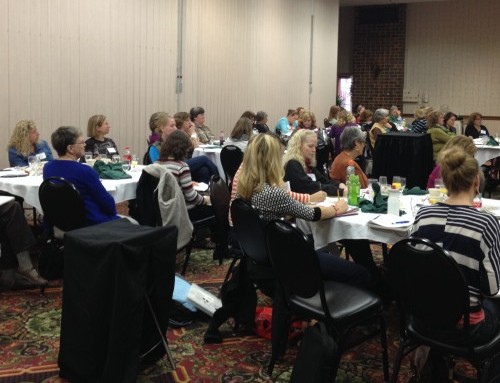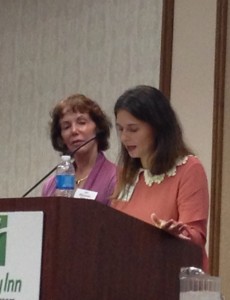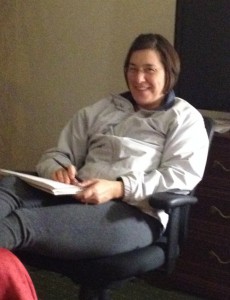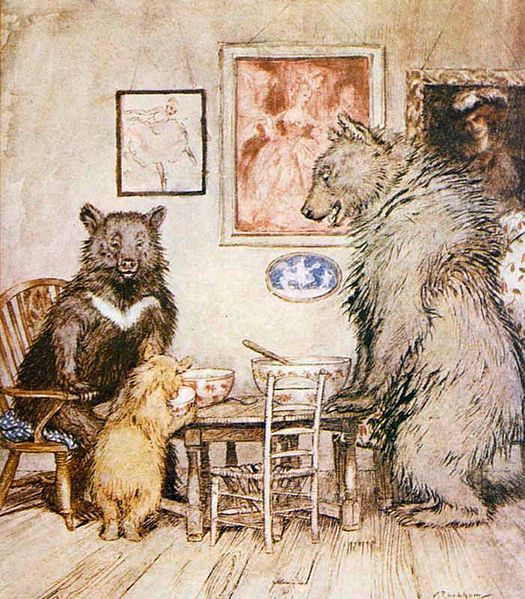“. . . I imagine that every now and then a book is picked up by a prestigious New York agent and sold to a prestigious New York publisher, but it is statistically akin to finding a four leaf clover. On the banks of the Dead Sea. In July.”
~Ann Patchett, THIS IS THE STORY OF A HAPPY MARRIAGE
 Elise Parsley found a four-leaf clover.
Elise Parsley found a four-leaf clover.
On the banks of Medicine Lake.
In November.
Metaphorically speaking.
Her book was picked up by the prestigious New York agency, Writers House, by their prestigious West Coast agent, Steven Malk, and sold to the prestigious New York publisher, Little, Brown and Company.
And, incidentally, Elise lives near Medicine Lake. And this all happened in November.
Even better than a four-leaf clover, Elise received a three-book contract. Now she and her work are hot topics for blogger friends like me; literary magazines like Publishers Weekly; and sweet tweets like Steven Malk’s December 17th and January 15th entries.
However, don’t let this lucky clover analogy give you the wrong impression. As Elise’s critique partner and friend, I can attest that no one worked harder or possessed more talent and determination to find success.
THE ELUSIVE FOUR LEAF CLOVER
HOW ELISE PARSLEY FOUND HERS AND WHAT SHE’S DOING NOW
1. When you developed your upcoming book, what did your creative process look like? For example, how did you decide what art medium to use? What came first: the protagonist or the plot; the title or the ending; the illustrations or the text?
“I actually came up with an image of the story’s antagonist first. I drew a classroom scene with a hulking alligator that happens to be dodging blame for tossing a paper airplane. I put the piece together to give my portfolio some fresh work before an SCBWI conference. After I drew that image, I figured I should have a good reason for an alligator hanging out in a classroom full of small children, so I developed the protagonist (the kid taking the blame) and created the story. The title came long before the ending. I love thinking up book titles. They’re so full of promise!
For this book, I’ll be creating the art using a digital tablet and Photoshop. I fell in love with digital painting shortly after graduating college and have been exploring it ever since.
2. What is your favorite part of the process, writing or illustrating? And why?
“My favorite part is when I’ve developed the writing enough to begin work on the images. The images fill in so many blanks and add a lot of punch lines, and it’s always satisfying to see the text and art paired together, rather than just mentally picturing it. I spend a lot of time snickering to myself before I get the pictures hammered out. Once they’re developed, I make my husband and critique group look at them to see if they’ll snicker too. Sometimes they do! And sometimes they give each other side looks and I can hear crickets chirping. That’s when I know my work is falling flat.”
3. How many drafts do you typically write before you feel a manuscript or dummy book is ready for submission?
“I don’t think I have a typical number yet (and probably never will). I kept track of at least 25 drafts for ALLIGATOR. But then there were various drafts of the storyboard and dummy after that, and I didn’t keep track of those numbers.”
4. What advice would you give writers and illustrators who are just starting out on the road toward publication?
Seriously? Your critique friends give each other side looks, Elise? They sound like losers. Hee. Hee.
“That’s a good one. Hmm. Well, you should definitely read a lot of books in your intended age range (we’re talking several gazillion, including the classics and the stuff hot off the presses). Also, you should make an effort to spend time with kids in that age range.
When it comes down to the work, it’s important to realize that it’s work. I would encourage writers and illustrators to be very intentional about creating time to do that work and set some office hours. Become part of a regular critique group (or two or three) if you can. A good critique group will give you fresh perspectives and ask valuable questions to push your story and characters. It’s also important to be on the lookout for ways to learn more and practice your craft. Continuing education can include (but is not limited to) signing up for an art or writing class (or degree!), attending writing/illustrating conferences (e.g. SCBWI conferences), and self-study (books, tutorials, etc.).”
5. How did you celebrate your three-book contract?
“When it was all said and done, my husband made me a tuna fish sandwich. It was delicious, and probably the only normal thing that happened that week.”
6. When will we see your books on bookstore shelves? And what are you working on now?
“Magnolia and her alligator will hit shelves in the fall of 2015. Stay tuned for more details! Besides Magnolia’s story, I’m working here and there on a new piece that takes place among a lot of snow and ice and cold (thanks, Minnesota winter, for your constant inspiration in that area).”
7. If you could be a children’s book character, which character would it be, and why?
Shucks, right now I’d have to say I’m aiming to be as awesome as Clementine’s parents in Sara Pennypacker’s series (you know, the CLEMENTINE books.) They seem like such a great pair who know how to set limits for their creative and hilarious kid, but they also know when to let her creativity roam free. I hope I’m half as cool as them when I’m a parent!
Thanks, Elise.
And congratulations to a talented and deserving writer and illustrator. You’re the best!
Anna Marras










